After the kitchen, the bathroom is one area of our home I wanted to tackle for moving towards zero waste. It’s where we use a lot of disposable consumables (baby wipes, cotton rounds, q-tips, razor blades), as well as a lot of plastic bottles and containers – shampoo, conditioner, hair products, deodorant, toothpaste, lotions, hand soap, etc. Like the kitchen, it’s the site for a lot of repeated purchases, and hence where I feel some effort will reduce a large quantity of waste.
There’s more I could do, but these are the changes I’ve implemented so far.
I switched to using bar soap at the sink a long time ago. My initial goal here was to use more natural products, but using bar soap – provided you can buy it in recyclable packaging or unpackaged – is zero waste as well. You may hear or think a lot of things about the germs on bar soap, etc. That is a whole other discussion – but I’m aware of it and I don’t think it’s an issue. And as for the occasional hair on the soap, or sogginess or the slight messiness over liquid soap…I’ve pondered these inconveniences, and at this point, I’m thinking that they’re first world problems. Bar soap is just fine.
Speaking of bar soap, we have a soap ecosystem in our home. Once the shards of soap get too small to use easily, I transfer them to my homemade soap saver, which is an old stocking drawstring bag. I had a more glamorous version of this that came with some soap, but it fell apart, and this is my homemade equivalent, made from a hateful old compression stocking I was forced to wear during a long-haul flight while pregnant. Ugly as a stocking, ugly as a soap saver. But it works – it converts old soap to wonderful lather that’s great for shaving.
Below is my bar soap in the shower (yellow bar on the left). On the right is a new trial product, a pink solid shampoo from Lush. This bar is advertised as a way to avoid plastic shampoo bottles. Not being a liquid, it also doesn’t need (as many) preservatives, and although it’s not a 100% natural product, it does have a short ingredient list. Truly natural shampoos are very hard to make work, I’ve found – the gentler soaps and detergents tend to react with hard water and not to wash cleanly away, making my scalp itchy. So a zero-waste, not-so-bad shampoo seems like a good compromise.
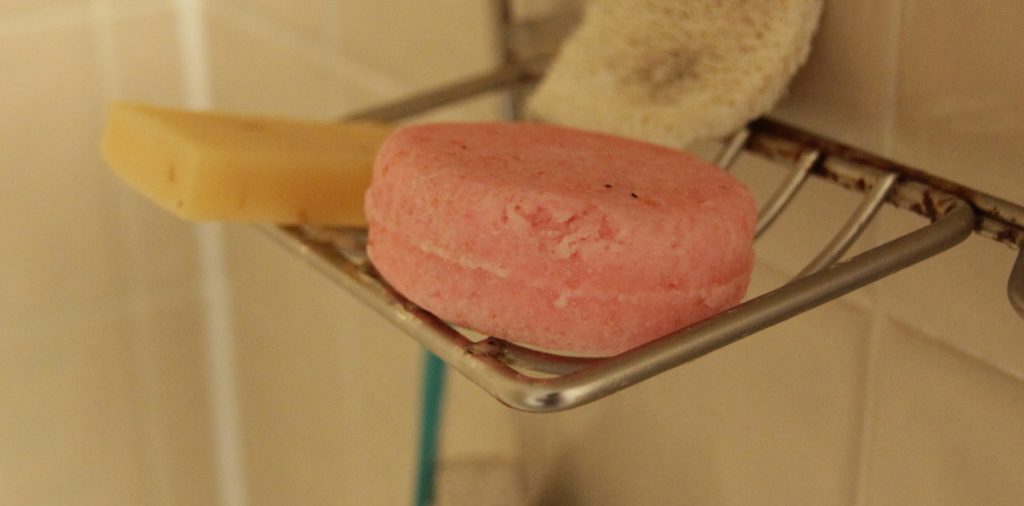
FYI, the trick to using bar soaps in the shower is to give them a well-drained place to sit. Our hanging rack is at the far end of the shower from the shower head, so everything dries thoroughly and never sits in water. But apparently that’s not enough to keep the metal rack from rusting, as you can see in the photo
Another zero waste product I’ve been enjoying is a facial scrub made from oats blitzed in a blender. I buy my oats in bulk from bins, but even barring that you can generally buy them in cardboard, and you don’t need much. To use the oats, I take about a teaspoon in my hand, add a little water to make a creamy paste, and then use like a cleanser. It doesn’t remove makeup, so I use oil cleansing beforehand. This two-step oil cleanse plus oat cleanse has worked nicely for me. It’s like a natural version of the two-step cleansing that’s popular right now from Asian beauty trends. I will say, it’s a little messy to use the oats, and if they weren’t pulverized I’d be worried about my drains, but a lot of rinsing and a wet cloth remove most of the oaty bits.
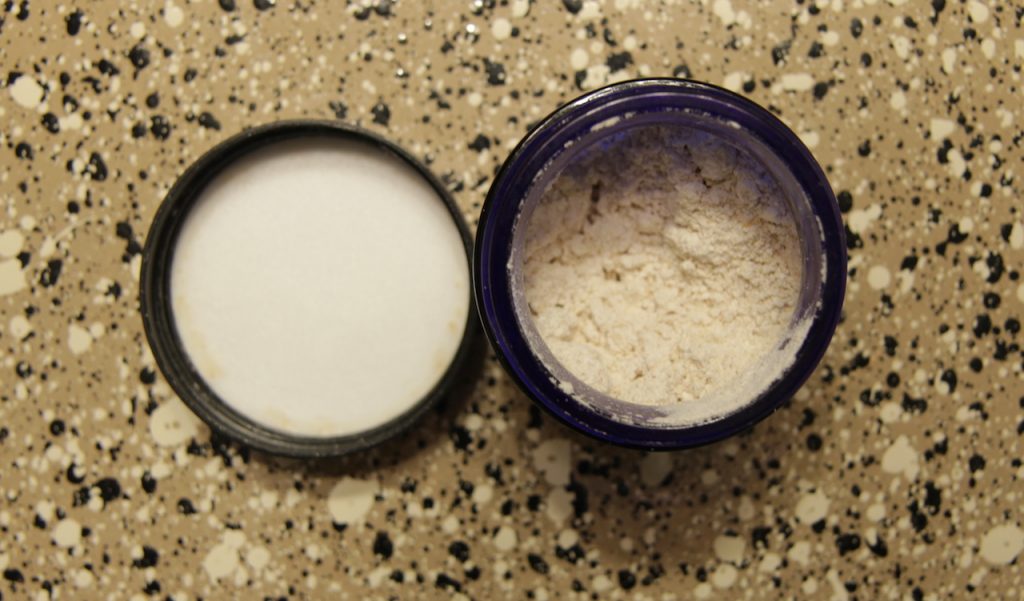
In case you’re wondering what oats have to do with cleansing, I did a bit of research and discovered that oats contain an organic soapy substance called saponin. I think this causes the slight bubbling when oats mix with water, and apparently does have a mildly cleansing effect, so I think there’s some real cleaning going on.
Finally, after much dithering I am embarking on a trial period for a safety razor which you see below in its stainless steel beauty. The selling point of this is that the blades are metal only (biodegradable – I don’t think you could recycle blades, could you?), and usually come in minimal packaging, unlike the disposable cartridges which are mixed materials and over packaged. Bonus: they are waaaaaay cheaper than any of the usual disposable razor cartridges. Extra bonus for me: Mike had an old unused safety razor and about 3462 blades from an accidental overbuying, so I could conceivably shave my legs for the next 10 years at almost no cost. (All figures are approximate. I don’t know how many blades he actually has, but it’s a lot.)
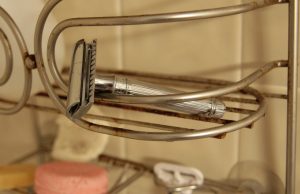
Zero waste aficionados all over the internet assure me that it’s so easy to use a safety razor, but my experience thus far is mixed. That thing is sharp. I once got a cut on my ankle that hurt for days. It also takes a long time, which makes for long showers and those aren’t particularly enjoyable for me in my current life. But my last Venus blade is coming to its end, and as I looked at the $12 replacement heads week after week in the store and didn’t buy them, dithering, I finally decided to go cold turkey and give the safety razor a real try before condemning it. The idea is that perhaps experience will make it easier to use. I’m also investigating ways of using it not during a shower, to avoid the wasted water and the inconvenient timing.
Finally, for toothpaste, dental floss and deodorant containers, there’s a recycling program available through Terracycle which allows you to mail containers to them, postage-free, for recycling. I’m collecting our containers and will give this a try.
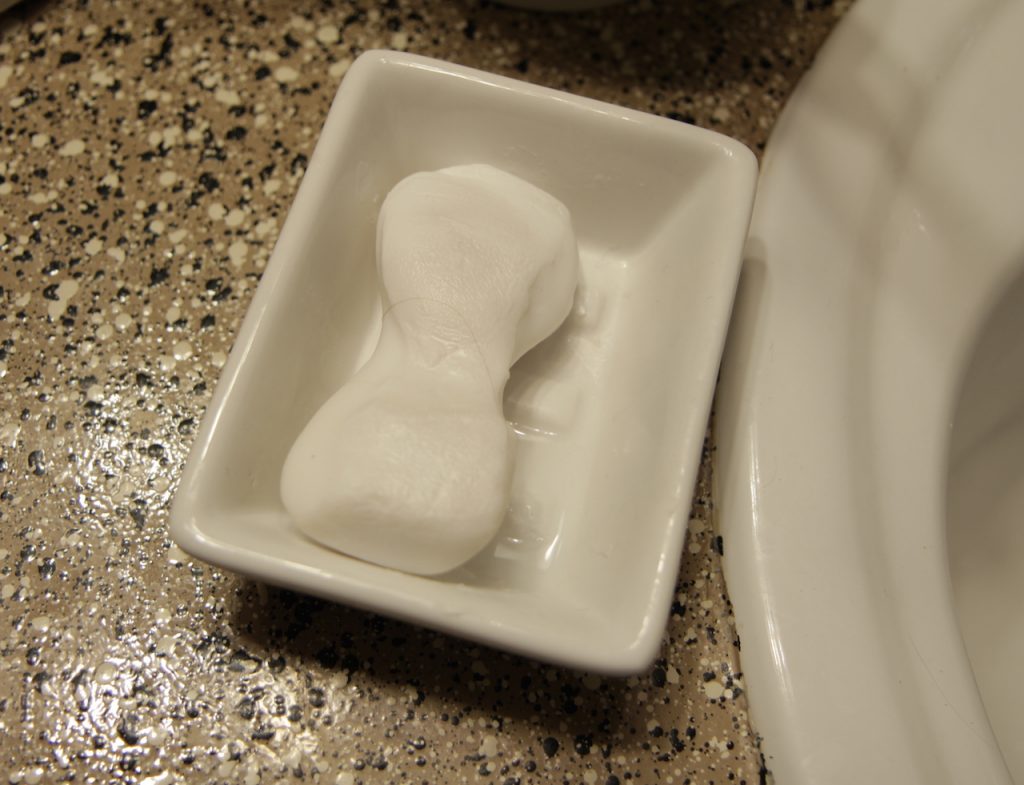
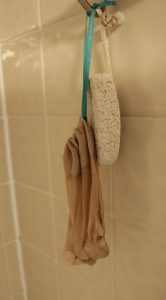
3462?! There are barely 3000! 🙂
This post had me laughing out loud — you’re a great writer. Our bathroom is on my list and it’s kind of stressing me out because there seems like so much to do. I haven’t gotten a safety razor yet, but that’s gotta happen soon. I’m just afraid of a complete bloodbath, as I lack general patience.
And how can bar soap harbor bacteria? It’s SOAP. My grandparents always had bar soap in their bathroom — grandma had some sort of doily in the dish to sop up the water.
Your sock soap saver is genius, by the way.
Thanks! My two biggest safety razor tips at this point are 1) don’t apply pressure, just let the weight of the razor itself rest against your skin; and 2) shave downwards first in the direction of hair growth, then upwards on the second pass – this tip is from my husband and it really helps reduce cuts. You can find lots of help online – but tip 2 that I mention here is something I haven’t ever heard elsewhere.
Late reading this, but, I laugh about the “safety razor” issues. These were the type of razors that I first began shaving my legs with, and used them for years, as this is all that was available. I grew up with six sisters and we used one razor, just had our own blade.
That’s interesting to hear! I saw a magazine article from an old women’s magazine once which was about a bath time routine and the picture of the razor looked like a safety razor, so I knew that this must have been typical at one time.
It seems like the safety razor may be like many things – we (of my own generation) are so used to the modern version we are afraid of anything else! Thank you for providing a different perspective!